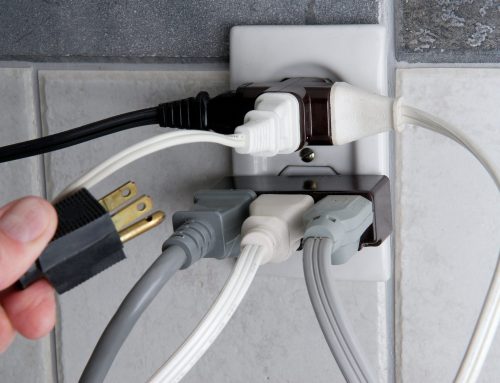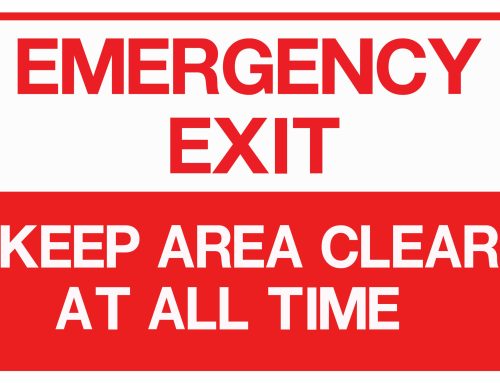Businesses are reopening after weeks of shut down as a result of the COVID-19 pandemic. As businesses reopen, there are a number of precautions and restrictions to be taken to ensure the safety of all employees and customers. While these precautions are only short term and intended to protect us from the spread of virus, they can also create fire hazards and other dangers.
Ingress & egress
Means of egress is defined as a continuous and unobstructed path of travel from any point in a building or structure to a public way that consists of exit access, exit, and exit discharge. The NFPA sets the requirements for the location of exits, number of exits, and access to exits. The NFPA also has requirements for signage, stairs, corridors, locks, door width and arrangement, and more. An experienced and licensed professional can help business owners ensure any COVID-19 related changes do not affect ingress or egress requirements or fire safety measures which may break fire code.
Social distancing and new restrictions on how many people can be in a building at once have caused businesses to “reroute” traffic of people entering and exiting a building. However, FEMA warns that social distancing approaches to controlling building occupant flow have resulted in the potential for public safety to be compromised by way of blocked or locked emergency exits to limit or prohibit access to portions of a building.
Each building is equipped with the appropriate number of emergency exits and coordinating signage. The number, placement, and capacity of exits is based on a number of factors that include type of occupancy and use, travel distance, and separation of exits.
Social distancing measures do not affect these requirements. It’s important that building owners acknowledge these exits are critical for life and safety measures.
Social distancing & occupancy
Occupant loading and type of occupancy determines the number of exits, doors, and stairs needed to evacuate people in the event of an emergency. New social distancing requirements mean that businesses must reconsider occupancy and flow of traffic while also adhering to fire code requirements.
Social distancing requires 6 feet between individuals. Not all businesses can achieve this requirement. FEMA recommends one method for calculating social distancing occupant loads to maintain safety. One way is to calculate the area of a circle with a radius of 6 feet, or about 113 square feet per person. Some businesses may need to reduce staff or customers to achieve these requirements. However these requirements are achieved, the business owner must not make changes to occupancy or occupancy type without first making appropriate changes. A local fire protection company or your local fire department can help business owners with any safety questions regarding these changes.
Workplace fatigue
This pandemic has taken a toll on us all; emotionally, mentally, and physically. Employees may be overworked, overtaxed, or simply overwhelmed. Employers may be asking more of employees or employees may be having trouble in their personal lives and not taking care of themselves at home. Lack of sleep and depression are major cause for concern when it comes to safety in the workplace.
Those working in essential services are even more at risk of stress and the physical impact of increased demand related to the pandemic. This is the perfect recipe for disaster from a safety standpoint. Depending on the industry, worker fatigue can lead to accidents and injury.
So, what can employees do when they feel too fatigued to work safely? The CDC recommends that all employees and employers recognize these are stressful and unusual circumstances and that employees may need more sleep or time to recover. It’s important to know what to do if you feel too tired to work safely. Some ideas put out by the CDC include:
- Use a buddy system while you’re at work. Check in with each other to ensure everyone is coping with work hours and demands.
- Watch yourself and your coworkers for signs of fatigue. When you see something, say something to your coworkers so you can prevent workplace injuries and errors.
- Find out if your employer has a formal program to help you manage fatigue on the job. Read information about the program and ask questions so you fully understand your employer’s policies and procedures for helping employees manage fatigue.
- Report any fatigue-related events or close-calls to a manager to help prevent injuries and errors.
Do not work if your fatigue threatens the safety of yourself or others. Report to a manager when you feel too tired to work safely
Fire Systems, Inc.
Fire Systems, Inc. has been a trusted source for all things fire protection for over three decades. We are here for our customers in these unprecedented times. Our long-lasting relationship with local fire officials means that we can the knowledge and access to information about the most up to date fire code requirements. If your business is planning to make changes in the way your business operates, contact us to make sure you are not in violation of fire code. Fire safety is critical. These are short term changes, but the impact of not being prepared for a fire emergency are long lasting. Contact us today at 770-333-7979 or visit our website for more information.






